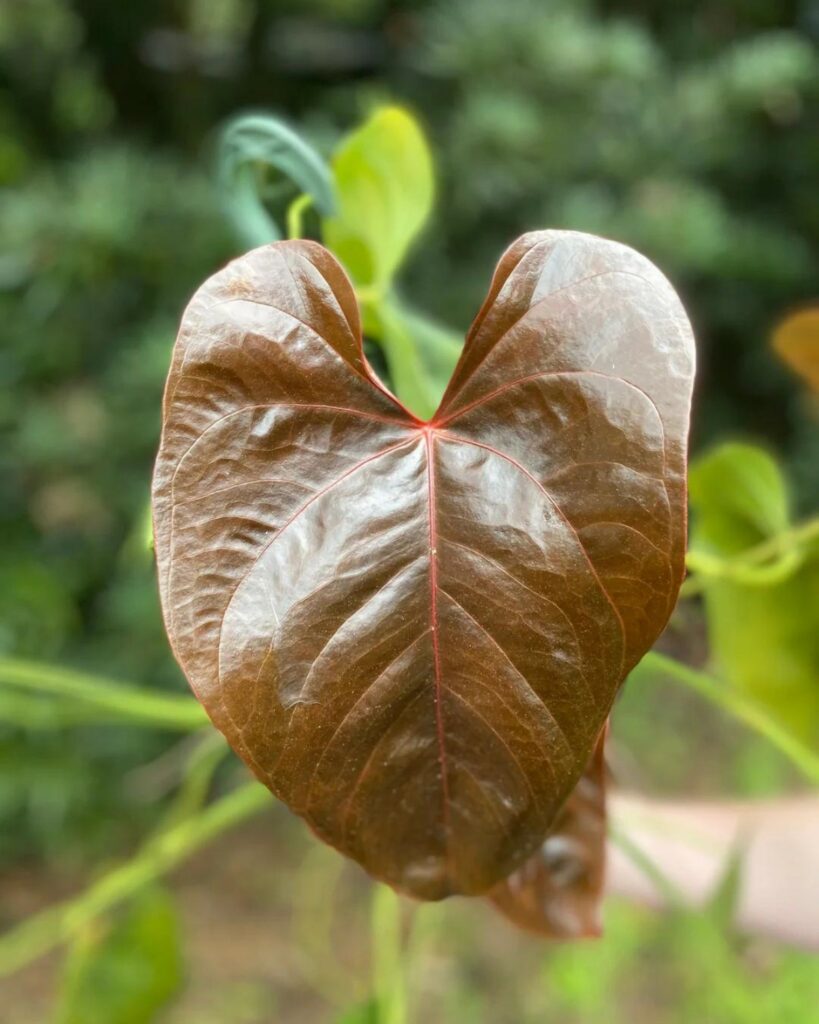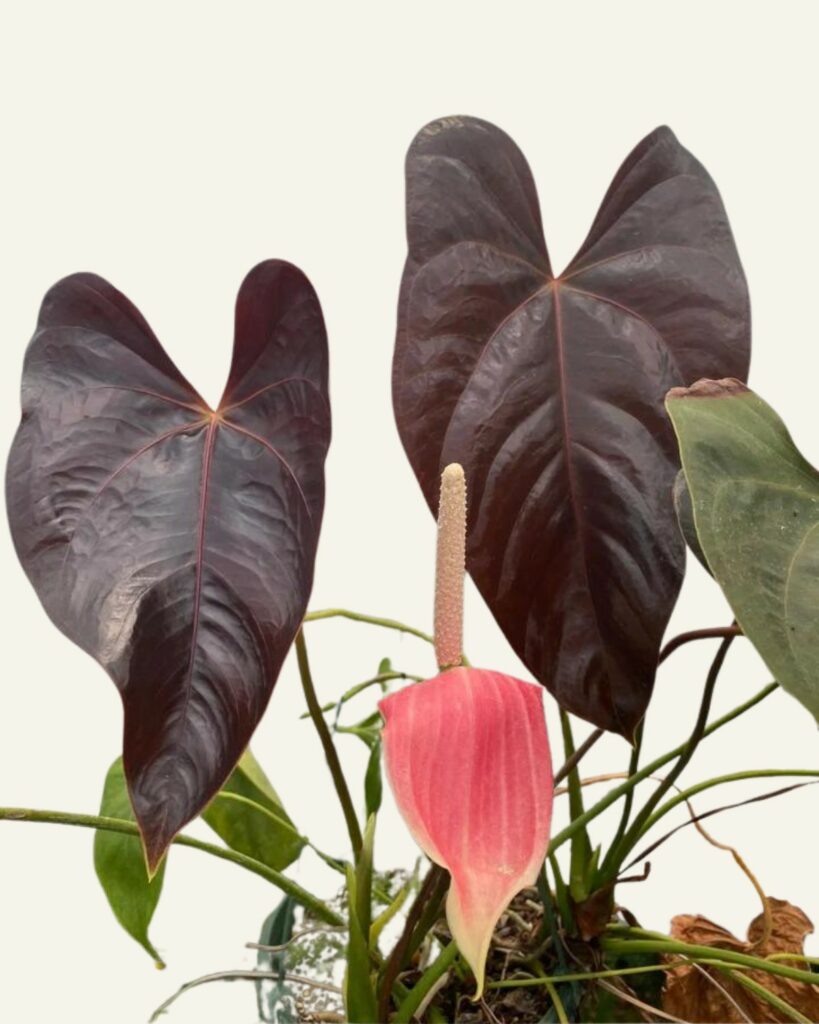Anthurium Moodeanum stands out as an eye-catching dark leaf gem among anthuriums. Not only does this rare aroid strike a statement in any room, it invokes a strong sense of allure.
From vibrant pink roots to deep maroon new growth, this dark beauty delivers a visual punch at every growth stage.
Let’s dive into what is known about this anthurium, explore its care requirements, and find out similar-looking anthuriums.

Anthurium Moodeanum Heart-Shaped Leaves
When this seedling begins its life, the leaves will go through a metamorphosis of colors. In the early stages of growth, the leaves start with a lush shade of green. As the leaf ages, it settles into an olive green tone while the textures shift from a semi-gloss to eggshell.
Once it reaches maturity, the emergent leaves transition into a stunning chocolate maroon color or burgundy, darkening as it extends outwards to fill an elegant heart shape.
Even the texture of the leaves begin to go through their own metamorphosis!
It starts with nearly no noticeable veins. With every leaf that it pushes out, the central vein becomes more prominent until it reaches maturity, where hues of pink and red flood the sinus and veins.
The bigger the leaf, the wider the veins stretch out, creating fine webs of faint pink across the surface.

Source: Plants and Pamperin
The roots are epiphytic which allows this anthurium to latch onto different surfaces, making it a great pairing with moss poles, tree bark, and trellises.
It can reach around 2 to 3 feet height indoors with optimal conditions, but has the potential to grow bigger outside.
Anthuriums don’t have blooms typical to other species, but rather inflorescences, which are complex structures that include both male and female reproductive parts.
The spathe comes out in a vibrant pink color, with soft white streaks that fade into a greenish tip while the spadix emerges as pale pink, nearly white colored. As it grows, the tip can become a bit more yellow toned.
What’s known about Anthurium Moodeanum origins
The enigmatic Anthurium, of still unknown origin, traces back to John Mood’s 2010 Hawaiian cultivation and has since been slowly making its presence in the collections of avid aroid enthusiasts.

Source: Plants and Pamperin
Anthurium Moodeanum Care Tips
Soil
This plant is prone to overwatering and root rot, so giving it a well-draining, coarse soil would benefit best. If making your own medium, it’s recommended to use chunky orchid bark, sand, peat moss, perlite and/or coco coir to have plenty of drainage. Check out my recipe for aroid potting mix.
Lighting
Anthuium Moodeanum is a tropical plant that does well with medium to bright indirect light. If you’re planning on keeping it indoors, a brightly lit corner would work, just remember to rotate it every few weeks to ensure all the foliage receives light. Providing it with supplemental light would speed up its growth.
Take a look at my comprehensive lighting guide for anthuriums.
When given plenty of bright indirect light, some observed that the emergent leaves will stay darker longer, before gaining a greener undertone.
If you’re thinking about having it outside, be aware that sunburn can be fatal if the plant is scorched badly enough. To avoid too much sun exposure, place it somewhere low to the ground where there is plenty of filtered light. Under a patio or tree would give it enough bright indirect light.
Watering
Like orchids, anthuriums have epiphytic roots that allow them to latch onto different surfaces, thus getting their water from the humidity and environment. When it’s time to water, make sure the medium is completely saturated before allowing it to drain off the excess. Making sure the roots aren’t sitting in water is important to avoid rot from developing.
I wrote about watering anthuriums in this comprehensive guide: Water Like a Pro !
Humidity
To promote growth, maintain high humidity for these tropical plants, ideally above 50%. Dry indoor air can stunt their development. Positioning them near a humidifier or within an enclosure can effectively increase humidity.
Temperature
Most tropical plants don’t do well in colder climates, and Anthurium Moodeanum is no different. For optimal health, maintain this plant’s environment between 65 and 85 degrees Fahrenheit. Avoid cold drafts during winter times.
Fertilizing
You can use mild fertilizers to add extra nutrition but remember to dilute any concentrations to prevent fertilizer burn on the leaves. I fertilize all year round.
Pests and Diseases
There’s no plant that isn’t susceptible to pests and diseases. Here are some very common (and annoying) pests and diseases that your Moodeanum might catch.
Fungus gnats
Fungus gnats are more than just annoying; if left untreated, they can cause real damage. These tiny flying bugs lay their eggs in moist potting medium, and the hatching larvae can harm roots, stunting the plant’s growth. Simply hold off on watering for a while, and the problem will naturally go away.
Spider mites
Spider mites often go under the radar due to their tiny size and nearly faint webbing. By the time the damage is noticed, the infestation has already been established. These mites range from brownish red to black specks that move slowly across the leaves.
You’ll notice a reddish residue after smashing some. You can use isopropyl alcohol on a q tip or cotton ball to wipe and clean the entire plant.
Avoid putting alcohol directly onto the leaves, as you can cause cosmetic damage. Another solution is to use watered down dish soap to wipe the entire plant down as well.
When you’re done cleaning off the plant, you can use neem oil to sterilize the surface and discourage the bugs from coming back.
Check out other pesky pests your Anthurium might catch in this guide.
Root rot
Root rot can happen to any plant, so if your Anthurium Moodeanum falls victim, do not fret. Firstly, you’re going to want to assess the roots.
Take that baby out of the pot, and gently remove as much medium from the roots. If they’re blackened, mushy, slimy, stinky, fishy, or just fall apart… then it’s gotta go. Make sure you use sharp sterile sheers to avoid any contamination.
Remove as many dead roots as you can before rinsing them off. If the rot is severe, you can soak the roots in a hydrogen peroxide solution.
Avoid high concentrations of H2O2, opt for the 3%, 1 part hydrogen peroxide with 2 parts water. Let the roots soak for no more than 15 minutes before repotting. Try to use fresh sterile soil to avoid contamination by reusing the soil prior.
Anthurium diseases are not a walk in the park, so arm yourself with knowledge to spot and treat them early. You can read about anthurium diseases in this guide.
Anthurium Moodeanum lookalikes
Anthurium Moodeanum is often confused with a few other anthuriums due to similarities in their appearance. Some lookalikes include Anthurium ‘Red Beauty’, Anthurium Queen of Hearts or Anthurium Chamberlaini.
Have a Moodeanum but craving other black beauties? Here is your guide to black anthuriums.
With proper care and managing, Anthurium Moodeanum plant will thrive and give back with the most exquisite leaves. It is a showstopper among anthuriums. It brings a whole mood into the atmosphere, just like its name. Grab it if you can!!!

